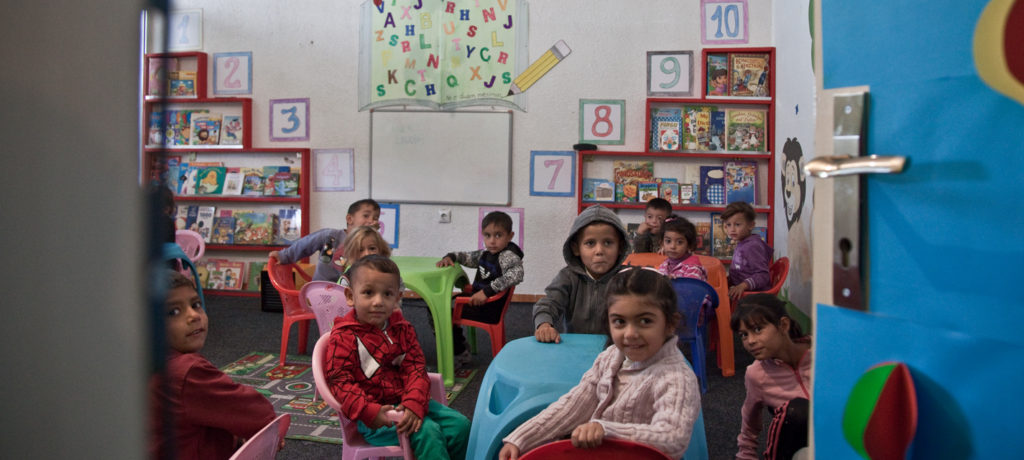A typical Saturday for Nexhie Faqi isn’t the same as for other Kosovar 14-year-olds. The eighth grade student from Fushe Kosova’s Selman Riza school spends every weekday helping first grade kids of her Ashkali community with their learning. Together with around half a dozen youngsters, she is one of over 100 volunteers at the Ideas Partnership center in her municipality.
The organization — whose primary focus is education of minority communities — organizes Saturday activity classes for children who need catch-up lessons, while also providing them with fun activities and a healthy snack. Located between the houses of the poverty stricken “Neighborhood 29,” on work days the Ideas Partnership center also serves as a kindergarten for around 80 children, mostly Ashkali, aged between 3 and 5.
For Roma, Ashkali and Egyptian communities, opportunities and access to education remain highly problematic, with a low level of general attendance in compulsory education, a lower rate university education attendance, and high dropout rates, particularly for girls. Moreover, there are a limited number of Roma, Ashkali and Egyptian teachers included in the Kosovar education system.
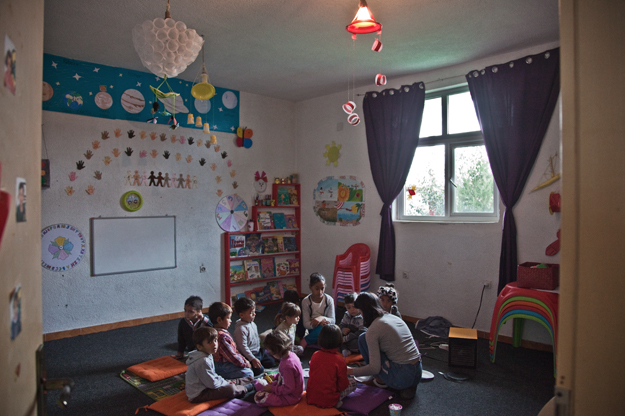
The Ideas Partnership organizes Saturday catch-up classes and a kindergarten for Roma, Ashkali and Egyptian children.
This is why, every Saturday morning from nine until noon, Nexhie teaches children who need help in Albanian and English languages and in mathematics. For the rest of the afternoon Nexhie becomes the student, as older volunteers mentor her, and others of her age.
“I want to be a teacher one day; I am so happy that I can come here and have a great time with the kids,” says Nexhie. “Then an older teacher comes here and teaches me the things that I want to understand better.”
Forgotten generations
The dream of completing an education has long been a distant one for most members of Roma, Ashkali and Egyptian communities. The period after the 1999 war in particular found them living in extreme poverty and subject to discrimination. The high rates of poverty and unemployment of Kosovo’s Roma, Ashkali and Egyptians — who, based on the 2011 Kosovo census, make up 2.06 percent of the population — make these communities the most excluded in Kosovar society.
“After the war, I was doing manual work from 7 in the morning until midnight. When you work like that, there is no space to learn."
Jashar Gashi
According to a detailed 2009 report on the situation of Roma, Ashkali, and Egyptians by the Kosovo Foundation for Open Society (KFOS), the average family income across all three communities is just 119.68 euros per month — approximately 21.37 euros per month for an individual or 71 cents per day. A 2010 UNDP report estimates unemployment rates among Roma, Ashkali and Egyptian communities to be higher than the national average: 75 percent of young men under 35 are unemployed. As many families also depend on daily physical labor, this in return affects the education prospects of their children, who often end up having to shoulder part of the burden.
“It can happen that a family spends the whole day on the ground collecting bottles, and it is terrible that they earn only 3 euros by the end of day,” says Jashar Gashi, administration manager at the Ideas Partnership’s Fushe Kosova center. “All the family members sell [bottles] only for 3 euros.”
Gashi’s own dream of attending university was fulfilled only last year; the 37-year-old is in his second year of public administration studies at the private AAB University. He managed to finish high school only after the Kosovo war, when he was already in his 20s.
“I am very happy … although this dream was supposed to happen a long time ago,” says Gashi. “After the war, I was doing manual work from 7 in the morning until midnight. When you work like that, there is no space to learn. I would carry around 120kg in weight from the truck. But this is life.”
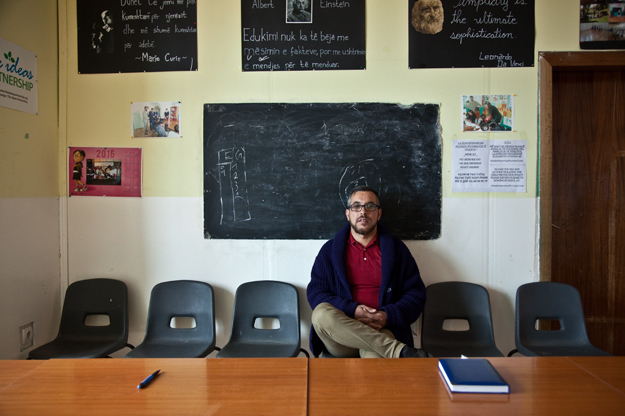
Jashar Gashi started university last year after his education was interrupted during and after the Kosovo war.
The deeply rooted historic exclusion of Roma, Ashkali and Egyptians has affected their education from generation to generation. Although the ’70s saw an increase in Roma, Ashkali and Egyptian children completing primary and secondary education due to the inclusive efforts of the Yugoslav system, attendance drastically dropped during the ’90s. During these years, the discriminatory measures of the Milosevic regime saw the majority of elementary and high schools ethnically divided, or even completely shut down for non-Serb communities, as was the case with the university; instead, education was organized in private houses in parallel with the official system.
This particularly affected Roma, Ashkali and Egyptians born in the mid ’80s. According to a 2012 survey conducted by Balkan Sunflowers — an NGO focussed on community, human dignity and youth — only 34.9 percent of that generation completed eight or more years of education, while 36 percent of the generation have no education at all.
“I think the education of children starts 20 years before they are born,” says Muhamet Arifi, Balkan Sunflowers’ executive director. “In 1989, Roma, Ashkali and Egyptians dropped out of schools because of the security [situation] or distance from the parallel education places … and most of them, even if they are willing, [today] can’t help their children in education and can’t provide comfortable spaces to learn at home.”
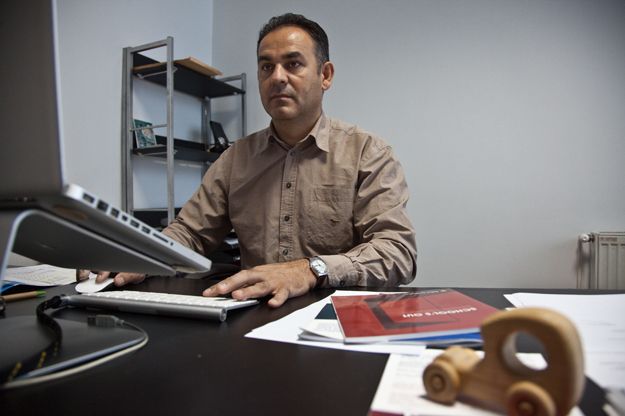
Muhamet Arifi highlights poor education among many Roma, Ashkali and Egyptian adults as having a big impact upon the education of their children.
According to the KFOS report, illiteracy rates are very high among Roma, Ashkali and Egyptian communities: 19.93 percent of 857 survey respondents stated that they have not finished one year of education. The majority of adult respondents — over 96 percent — have not even finished the obligatory level of education, with only 12 percent having finished nine to 12 years of education (meaning at least some high school education). Meanwhile, only 2 percent of them had completed 13 or more years of education.
Gashi from the Ideas Partnership points out that the organization tries to work with children who grew up with very few role models for schooling, as in many cases their parents had to earn money by scavenging in the garbage, or by collecting steel and bottles.
“Many parents, born in the ’80s, have kids who should be in the first-grade of elementary school,” says Gashi. “How can they help their child in reading and writing when they might be illiterate themselves?”
Strategic failures
The Strategy for Integration of Roma, Ashkali and Egyptians was approved in 2010. Through various activities and interventions it set out a course of action to improve the position of three communities in eleven sectors, including legislation, education and employment. The strategy received widespread criticism from the start.
Monitoring reports subsequently suggested that the strategy failed to improve the lives of Kosovo’s Roma, Ashkali and Egyptian communities. After seven years of implementation Roma, Ashkali and Egyptians still face many challenges in practicing their basic rights to — amongst other things — health, employment, justice and social welfare, as their representation in public institutions and decision making processes remains very limited.
In 2015, the government together with relevant actors, designed a new draft strategy for the period 2016-2020. In order to meet its targets, the new strategy planned interventions in only four sections: education, employment and social issues, health and housing. Government representatives told K2.0 that the new strategy will soon be finalized soon but could provide no further information.
In order to address fundamental problems for Roma, Ashkali and Egyptians — the majority of whom live in the municipalities of Gjakova, Fushe Kosove, Prizren, Peja and Ferizaj — KFOS, in cooperation with OSCE Mission in Kosovo and the government of Kosovo, created the Strategy for Integration of Roma, Ashkali and Egyptian for the period 2009 to 2015. Signed in 2010 by the President of Kosovo at the time, the action plan foresaw the undertaking of measures to strengthen the protection of communities’ rights and their full integration into society.
Despite a number of amendments made to legislation providing full community rights, all monitoring reports of the strategy indicate that the government is far from succeeding in achieving greater inclusion of Roma, Ashkali and Egyptian communities within broader society.
The strategy’s targets were due to be met last year, but according to communities’ representatives, NGOs and donors interviewed by K2.0, “almost nothing” has been achieved. They point to a lack of political will, poor coordination between central and local institutions and non-allocation of the budget initially promised as reasons for the government’s failure to implement the strategy.
“The strategy included EU grants, our [donor] grants and government grants, but the government grants were never allocated,” says program coordinator of KFOS’s Minority and Roma program Vera Pula.
Small steps forward
The one exception to the widely perceived failure of the strategy is in the education sector, where some progress has been made.“ I would exclude the Ministry of Education in this [assessment of government inaction],” says Pula. “It was the most active compared to the inert approach of the government, and it has done more than any other relevant ministry.”
Pula points out how unemployment, economic conditions and education are part of the same vicious cycle and that focus on the latter holds the key to breaking it. “It is important to help education in order for [Roma, Ashkali and Egyptians] to be included in mainstream society; with education we will have rights equal to other communities,” says Pula. “That’s why the interventions in education are very important.”
A higher number of Roma, Ashkali and Egyptian children attending primary and secondary school, and the inclusion of Roma language, literature and history modules in schools with a high percentage of Roma children, have been mentioned repeatedly by government representatives as achievements of Roma, Ashkali and Egyptians inclusion and strategy implementation.
In fact, there is evidence of increased attendance of children from all three communities in schools, and an increasing interest of children and families in education. This is most obvious when compared to the situation a decade ago: The number of Roma, Ashkali and Egyptian children in pre-school education in Prizren, Gjakova and Ferizaj was 43; by 2015 this had increased to 163. The number of Ashkali children attending high school in 2014 was 79, compared to 22 in 2004. Moreover, the Ministry of Education is now providing elementary school textbooks without charge and university quotas for minority children, while civil society organizations provide scholarships, particularly for secondary school and university students.
However, this increase in Roma, Ashkali and Egyptians participation in education looks bleaker when compared to the rest of population. Based on Ministry of Education statistics for 2013/14 and the 2011 Population Census, the number of Roma, Ashkali and Egyptians in elementary education is 78.7 percent, compared to 94.7 of the total population. More worrying is the figure of 16.5 percent for participation in high schools compared to 95.3 percent of the total population.
While these participation figures indicate that dropouts from the three communities are still a significant concern, there is no accurate data on this phenomenon. According to the ministry, the definition of a dropout is not only a child who has abandoned school, but also covers those who were never registered for compulsory education at the age of six. However, unregistered children are completely invisible in institutional debates regarding school abandonment and aren’t included in statistics. Balkan Sunflowers has applied the inclusive ministry definition to suggest that the dropout rate for the three communities in Kosovo is over 90 percent.
Surveys conducted by organizations looking into the progress of education in Roma, Ashkali and Egyptian communities repeatedly confirm that difficult economic conditions, such as high poverty and unemployment, represent a serious obstacle to the continuation of education. Many parents mention their inability to afford clothes and learning equipment due to their personal circumstances.
“The economic situation forces the children to go out at traffic lights and ask for money,” says Balkan Sunflowers’ Arifi. “It is apparent that education is better now than it was 10 years ago but unemployment is very high … if a child is in the ninth grade and sees their father with a degree and unemployed, they will wonder why they need to go to university. They will find other alternatives. If there no measures are taken to employ them, then they will become demotivated.”
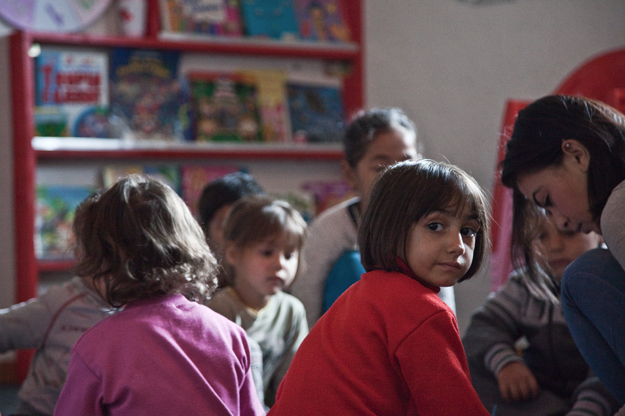
There have been some advancements in the education situation for Roma, Ashkali and Egyptian children in recent years but much needs to change to put them on a level playing field with their peers.
Kujtim Pacaku, the only Roma representative at the Kosovo Assembly, believes that the government’s failure to improve the position of Roma, Ashkali and Egyptians when it comes to employment and social welfare creates challenges for the three communities in practicing their right to education.
“I always said that the problems experienced by Roma, Ashkali and Egyptian communities won’t get solved if we go step by step,” he says. “If we are aiming to have good students, then those students need to have housing, food and education. Yes, we are giving scholarships but if students don’t have a place to learn, don’t have housing and food, then we can’t have high expectations.”
Exclusion at school
Despite economic factors, dropouts are also linked with the failure of schools to create an encouraging environment for children from Roma, Ashkali and Egyptian communities.
Segregation of classes by ethnicity was still a concern in Kosovo just a few years ago. During the 2011/12 school year, the European Center for Minority Issues (ECMI) Kosovo received reports of class segregation by ethnicity — a discriminatory practice that is forbidden by both state legislation and the European Convention on Human Rights — in three municipalities in Kosovo. After the intervention of human rights organizations, schools put Roma, Ashkali and Egyptian children in classes with Albanian children by the end of the year.
“We have been in Kosovo for many centuries and we are integrated but we need to be included in the social life. Inclusion starts at school."
Muhamet Arifi
The following year, Mustafa Bakija school in Gjakova repeated these segregatory policies by creating a special class with Roma, Ashkali and Egyptian children, but this time the incident attracted mass national and international attention. To date, no further reports of class segregation by ethnicity have been received.
However, despite increased efforts, research shows that poor treatment of Roma, Ashkali and Egyptian children by school staff remains a serious concern. Neglect and other forms of discrimination are still widespread, with Arifi from Balkan Sunflowers highlighting that many children from Roma, Ashkali and Egyptian communities are told to sit at the back of the classroom and are often not encouraged to participate in extracurricular activities with children of other communities.
Arifi suggests a wholesale change of approach is needed and that the target for inclusion of Roma, Ashkali and Egyptian children should not be considered to have been met with their physical placement in integrated classrooms: “Kosovo promotes integration and this is wrong,” he says. “We have been in Kosovo for many centuries and we are integrated but we need to be included in the social life. Inclusion starts at school … This is where Kosovo lags behind. It promotes integration and not inclusion.”K
Photos: Majlinda Hoxha / K2.0.




